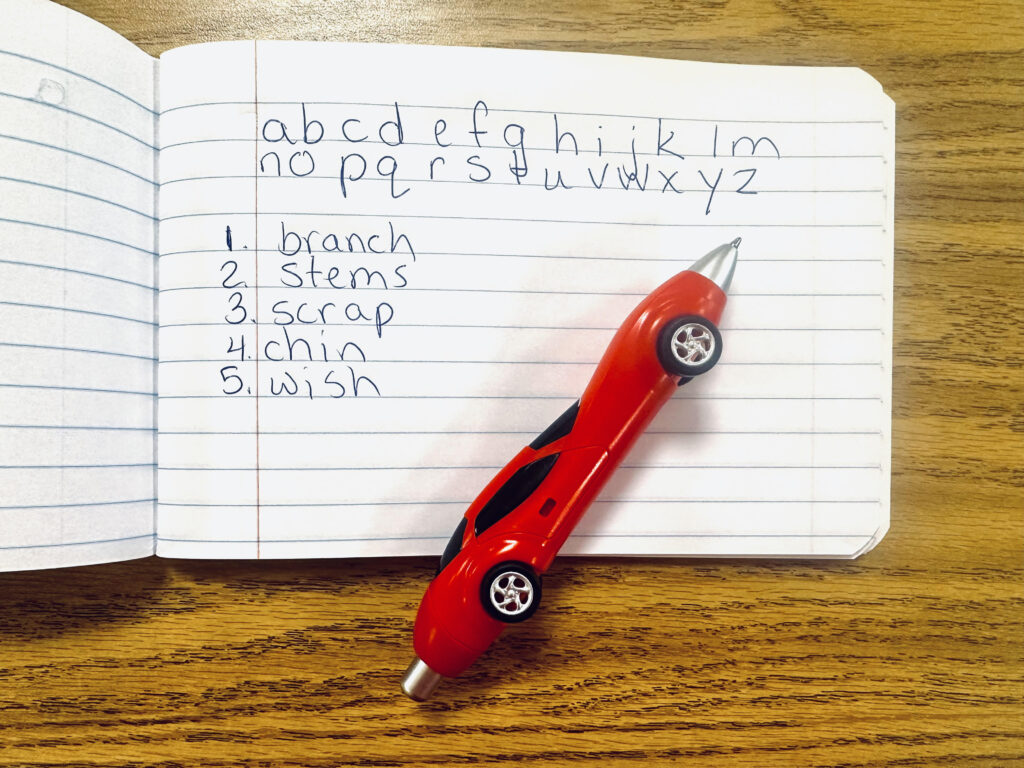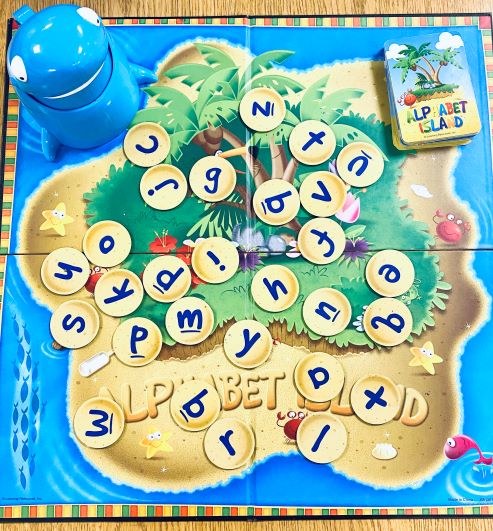
Share This:
Did you know it may take hundreds of exposures before a child can automatically identify a letter and its sound? When you hear that, teaching letter sounds can seem overwhelming. If you are a kindergarten teacher teaching the alphabet, you don’t know if it is the first time a child has seen the letter or the 400th. This is where a huge discrepancy lies for our children—some children have already had that exposure before coming to us, and some have not. So today, I want to give some ideas for giving children that repetition and exposure they need. When you have to literally expose children hundreds of times, you can run out of steam.
There’s a couple of guidelines I always try to follow for my intervention groups. One is that no matter the practice, the activity should be short. Two years ago, I took my kindergarten group at 3:00 PM every day, and I knew that my activities had to be quick or I would lose them.
When we are teaching letters, teach both the letter name and the sound. I know that some people will say to just teach the sound, but a rote knowledge of letter names is critical. When someone asks my how to spell my name, I don’t sound it out for them-I give them the names of the letters.
Another guideline is that, when possible, you want to distribute practice throughout the day. Because I’m an interventionist, I don’t have this luxury as much, but a classroom teacher could break this apart throughout the day during transitions or extra time. Even taking a single minute to practice letter names or sounds can have a big impact. For example, there have been times where I kept a deck of ABC flashcards with me at bus duty. As my student walked off the bus, they would quickly go through the deck and tell me the sounds. Multiple, short exposures throughout the day can help give you the necessary repetition!
Lastly, think about the time it takes to do an activity vs. the time payout. There are a lot of fun activities that are great for fine motor skill, engagement, etc. Just do not confuse your target. If it takes 30 minutes for a child to create something that results in 1 picture of a letter, than is not the most targeted use of our alphabet instruction.
There is no single correct sequence for teaching letter names and sounds. There are a few ways you can consider your sequence.
One way to sequence letters is by teaching a few consonants and vowels so that students can begin spelling words right away. Once students know a handful of letters, they can begin spelling CVC words. (Think how many words can be spelled with s, a, t, p, i, n). Search for the satpin sequence for an example!
Another way to think of sequencing letters is by formation. Fundations is a program that does this. In this sequencing, you are grouping letters together that are formed similarly. For example, if you can make the letter c, you can then make a, d, g, o, and q.
Whatever sequence your school or district chooses, it is important to have consistency. You don’t want one teacher teaching a certain order, while another teacher chooses a separate one. Our kids need to be seeing the same letters in the same order within a district.
But how can we give students the practice they need? Below you will find some quick ideas for practicing letter sounds.
An ABC arc is simply the alphabet in arc form. I give them only the letters they have learned, and they must match them up. Before putting them away, I ask each child to identify letter names or sounds. If you do not have time to ask children to read all of them, you can ask each child to name a couple. I use the alphabet arc from Florida’s Center for Reading Research.

You can increase the difficulty level by providing the alphabet arc in either uppercase or lowercase, and then providing magnetic letters that are the opposite.
This one is as easy as throwing uppercase and lowercase letters inside a bucket with rice, sand, or some other material (lentils are texturally fun too!). Ask children to find all the letters, then match up the uppercase and lowercase. Once again, I have them say the names or sounds when they put them away. This one is both engaging AND it takes very little time.

Children quickly learn the routine and can complete independently. Before putting them away, however, ask them to tell either you or a friend the names or sounds.
Simply changing up the way we ask students to write the letters can really change their motivation and engagement. There are so many different ways we can encourage students to write their letters. Some of my favorites are: dry erase boards, chart paper, and sentence strips. You don’t need anything fancy to get their attention! Even giving kids a marker or pen to use instead of a pencil has a huge impact on engagement.

I’ve talked a lot about fluency grids in other posts, but you’ll notice I don’t actually have any for the alphabet. I’ve found that with my intervention kiddos, this works best whole-group. I will write a bunch of letters in rows on anchor chart paper (you can do only lowercase or mix upper and lower.) Then, simply ask students to say the sounds. You can have students come up and point or “be” the teacher.

Starting in first grade, I have my students write the alphabet every single day (lowercase). But what do you do for kindergarteners who just don’t have the stamina or capabilities to write the alphabet? That’s why I created these missing letter alphabet sheets.
When I first started looking for something like this, everything was just too cute. I really don’t need my letters to be inside of cute clipart sun or have a clipart girl waving at me from the side. I just need my kids to write the letters of the alphabet.

So, I made something simple. 30 different missing letter alphabet sheets where the number of missing letters gradually increases. It is the scaffold my students need to go from not knowing their alphabet to being able to write their abcs independently.
We must always take our instruction back to the medium we expect them to be successful in. For children and their letter sounds, that is proficiency on paper. While I love using dry erase boards and other mediums, I know that my children must practice writing their letters daily on actual paper. Dry erase markers and magnadoodles are great for engagement and I use them, but we always have to remember that ultimately they are expected to write on paper.
For children who are just learning letter names and sounds, I only use paper with a midline (that dotted line in the middle). This helps to guide letter formation, and the lines are larger, which makes it easier for our students.
I have to admit, I’m pretty obsessed with interactive notebooks of all kinds. Every student of mine from k-5 has an interactive notebook. My youngest students have one for letters, then phonics, then morphology.
I created my alphabet interactive notebooks to give students initial practice with writing letters and identifying letters names and sounds. The students are first expected to trace the letter 4 times, then write it 4 times on their own, before finally closing their eyes and writing it four more times. When we have a student write it that many times, we are working to create a muscle memory. This should not be something students are simply doing independently. If a child writes a letter wrong 12 times in their notebook, that’s working to create the wrong muscle memory.

Underneath the letter writing, students circle 5 representations of that letter in a variety of fonts. Finally, the bottom activity asks students to find pictures where the beginning sound matches the target letter. I include both half sheets and full-size sheets.
Letter games are one of the best things about teaching kindergarten. There are a lot of great games you can play. My favorites are Pop*, the “shark game,” and bingo. Some of our students don’t play games with their family at home, and that is an experience I want them to have. All children should know the joy of playing games (and the consternation when they lose.)

I could keep going. Teaching letter names and sounds is one of the most joyful parts of teaching. I love getting to see students begin unlocking the code that is written English. So just remember–keep it fun, keep it short, and keep it engaging. And don’t forget it can take hundreds of exposures, so do not despair if some children take longer. With repeated exposure and practice, they’ll get there in the end!
*As an Amazon affiliate, I may earn a small commission for purchases made through my links. Your support helps fuel my content creation. Thank you for shopping and discovering amazing new resources with me. Also, I would never share anything that I don’t believe in with every part of me!
Share This:

Savannah Campbell is a K-5 reading specialist. She has taught her entire 12-year teaching career at the school she went to as a child. She holds two master’s degrees in education from the College of William and Mary. Savannah is both Orton-Gillingham and LETRS trained. Her greatest hope in life is to allow all children to live the life they want by helping them to become literate individuals.

Savannah Campbell is a K-5 reading specialist. She has taught her entire 12-year teaching career at the school she went to as a child. She holds two master’s degrees in education from the College of William and Mary. Savannah is both Orton-Gillingham and LETRS trained. Her greatest hope in life is to allow all children to live the life they want by helping them to become literate individuals.
Feeling overwhelmed with all the terminology out there? Want to know the key terms all teachers need to teach phonics? In this FREE Rules of English cheat sheet, you get a 5 page pdf that takes you through the most important terms for understanding English—you’ll learn about digraphs, blends, syllable types, syllable divisions, and move. Grab today and take the stress out of your phonics prep!
